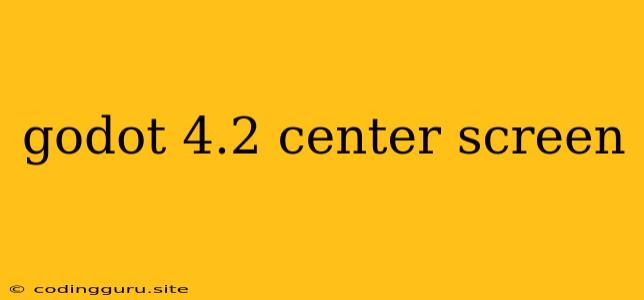How to Center Objects on the Screen in Godot 4.2
Godot 4.2 is a powerful game engine that offers a wide range of tools for game development. One common task is to position game objects on the screen, and a frequent need is to center them perfectly. This article explores different methods for centering objects in your Godot 4.2 games.
Understanding the Coordinate System
Before delving into centering techniques, it's essential to grasp the fundamental concept of the Godot coordinate system. In Godot, the origin (0, 0) is located at the top-left corner of the screen. Positive X values move to the right, and positive Y values move downwards.
Method 1: Using the Anchor Points
Godot's Anchor Points provide a flexible way to control how nodes are positioned and resized relative to their parent container. By manipulating these anchor points, you can effortlessly center your objects.
Here's how to center an object using Anchor Points:
- Select the Node: In the Scene Tree, select the object you want to center.
- Adjust the Anchor Points: In the Inspector panel, locate the "Anchor" property. By default, it's set to "Top Left". Change it to "Center".
- Set the Offset: Next to the "Anchor" property, you'll find the "Offset" property. Set both X and Y values to 0. This ensures that the object's origin is aligned with the center of its parent container.
Example: Let's say you have a Sprite node that you want to center on the screen. By changing its Anchor Point to "Center" and setting the Offset to (0, 0), the Sprite node will be perfectly centered within its parent container.
Method 2: Using get_viewport().size
Godot's get_viewport().size property returns a Vector2 containing the screen's width and height. This information can be used to calculate the object's position for accurate centering.
Here's how to center an object using get_viewport().size:
- Get Screen Dimensions: Access the
get_viewport().sizeproperty to retrieve the screen's width and height. - Calculate Center Position: Divide the screen width and height by 2 to get the center coordinates.
- Set the Position: Set the object's position using the calculated center coordinates.
Example:
extends KinematicBody2D
func _ready():
var screen_size = get_viewport().size
position.x = screen_size.x / 2
position.y = screen_size.y / 2
In this example, the KinematicBody2D node's position is set to the center of the screen.
Method 3: Using the center Method
The center method of the Control node is a convenient way to align the node's contents to the center. This is particularly useful for centering UI elements within containers.
Here's how to center an object using the center method:
- Ensure the Node is a Control: Make sure the object you want to center is a Control node or a descendant of a Control node.
- Set
rect_scaletoVector2(1, 1): If the node'srect_scaleproperty is not already set toVector2(1, 1), set it to that value. This ensures that the node's content is not scaled or stretched. - Call the
centermethod: In the node's script, call thecentermethod. This will automatically center the node's contents within its container.
Example:
extends Control
func _ready():
rect_scale = Vector2(1, 1)
center()
In this example, the Control node's contents will be centered within its container.
Method 4: Using the set_anchor_and_offset Method
For more fine-grained control over anchoring and offsetting, you can use the set_anchor_and_offset method. This method allows you to specify both the anchor point and the offset at the same time.
Here's how to center an object using set_anchor_and_offset:
extends Node2D
func _ready():
set_anchor_and_offset(Vector2(0.5, 0.5), Vector2(0, 0))
This code snippet will set the node's anchor point to the center and set the offset to (0, 0).
When to Use Each Method
The best method for centering objects depends on the specific context and the desired level of flexibility.
- Anchor Points: Use anchor points for simple centering and when you want the object to remain centered even as its parent container resizes.
get_viewport().size: Use this method when you need to calculate the center position based on the screen dimensions. This is useful for dynamic centering or for positioning objects relative to the screen size.center: Use thecentermethod for centering UI elements within containers, especially when you want the content to remain centered as the container resizes.set_anchor_and_offset: Use this method for advanced anchoring and offsetting when you need more precise control over how the object is positioned.
Conclusion
Centering objects on the screen in Godot 4.2 is a common task that can be accomplished in various ways. By leveraging the powerful tools offered by the engine, you can easily achieve the desired centering effect and create visually appealing games. Choose the method that best suits your needs and the specific requirements of your project. Remember to experiment and find the approach that works best for you.
